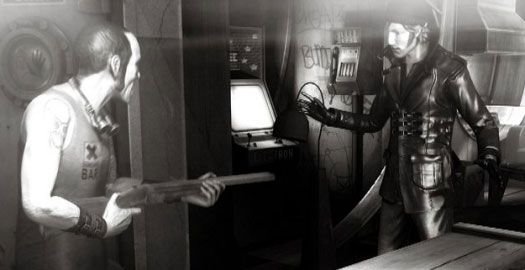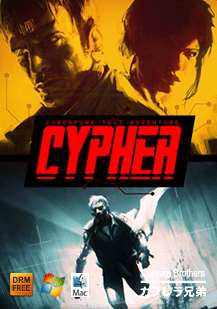Review for Red Johnson’s Chronicles: One Against All

Slowly but surely, Red Johnson’s getting around. The ginger-haired private eye first popped up in 2009, in the obscure Nintendo DS release Metropolis Crimes. Then came Red Johnson’s Chronicles, which arrived in 2011 exclusively for the PlayStation 3. With his latest adventure, One Against All, Red is finally going more mainstream, with an Xbox 360 release accompanying his return to PS3 and a PC version soon to follow. A benefit of this gradual expansion is that many One Against All players will be new to the Red Johnson universe, and therefore won’t notice that this sequel is essentially a carbon copy of the last game, with no real improvements. It does serve up some creative and challenging puzzles, but its weak story, frustrating interface, and numerous other flaws will be readily apparent to newbies and returning players alike.
After a brief recap of the story so far, One Against All picks up right after its predecessor’s cliffhanger ending, but that unresolved issue is quickly swept under the rug with a complete reset that takes place six months later. With a big price on his head courtesy of the local crime boss and ordinary citizens falling all over themselves to cash in, Red has taken refuge in the hardscrabble docks neighborhood where he and his brothers Black and Brown (ha, ha) grew up. Metropolis itself is an overcrowded, crime-ridden city and the docks are no exception, as Red learns firsthand when a barmaid at a local pub arrives at his table with a mysterious computer, a poisoned beer, and… a severed finger.
We soon learn that Red’s irresponsible younger brother Brown has been abducted, and Red mounts a search for the missing Johnson. This investigation is the thrust of One Against All’s plot, with hazy ties to Red’s status as a wanted man that sort of, kind of make sense by the end. Though this is unquestionably a story-driven game, the narrative is convoluted and weak, with unrelatable characters and a dodgy script peppered with inept sexual innuendo. Even before evading murder attempts became part of his daily routine, Red was something of a loner, so the introduction of his estranged brothers seems like the perfect excuse for some heartfelt drama. But the game falls completely flat in this area, and the distinct lack of believable emotion coming from Red or his brothers makes the rigidly predictable storyline and the perplexing supporting characters even harder to take. If you’re looking for a game with a great noir storyline, maybe with some character development and unexpected twists, stop right here: One Against All isn’t it.
The investigation itself is fairly straightforward by adventure game standards. Red talks to suspects, searches environments, and analyzes evidence to uncover leads. The evidence analysis is mostly limited to selecting an item among the clues Red has collected and pressing the “analyze” button on his computer at headquarters—nothing particularly challenging. There are some timed elements: a few dialogues where you have to choose a response before a timer runs out, and a handful of simple Quick Time Events during action sequences. These are easy and forgiving, but if you don’t succeed you can immediately try again. There’s nothing inherently wrong with any of this investigative gameplay, but nothing earth-shattering either. Then again, the investigation isn’t really the main attraction.
As in Red’s previous outing, you’ll spend most of your time in One Against All solving self-contained puzzles. These run the gamut from logic puzzles to jigsaws and sliders, from pattern puzzles to hidden objects to messages in Braille and Morse Code. The puzzles are loosely linked to the story, but usually in ways that don’t make much sense. One character keeps her refrigerator locked with a complex slider puzzle. (She also inexplicably keeps lube in her pantry, but that’s neither here nor there.) Fixing a broken cash register requires solving a Sudoku sequence. Oh, and you can only disengage an armed submarine by winning an Old West-themed shooting game. There’s also an unbelievable number of combination locks for Red to crack, with the code almost always hidden somewhere nearby just waiting for him to find it. (I think I've figured out why Metropolis has so many robberies…) In the first Red Johnson’s Chronicles, I enjoyed how the developers took a well-worn puzzle game format and integrated the brainteasers into Red’s investigation. Either they’ve done a worse job this time or the novelty has worn off, because the majority of One Against All’s puzzles feel shoehorned in, to an annoying degree.
That being said, the puzzles are the best thing this game has going for it, and many do provide a good challenge. I really liked one where clues integrated into the logos and artwork on cans of food needed to be deciphered in order to move the cans into specific positions, and another that required switching between security cameras to catch clues painted on moving trucks. Breaking into a bank of residential mailboxes using various logic clues is a good one, too, but when I realized afterward that solving this particular puzzle was entirely unnecessary to progress the story, my enthusiasm dwindled. One Against All has several such “gotcha!” moments that can detract from the satisfaction of moving forward. (Feeling like the designers duped me into wasting my time isn’t exactly a warm fuzzy.) Also, even though it’s been over a year since I played the original, I recognized some puzzles as direct copycats from the first game. These still provide a challenge but the repeats feel lazy. Another complaint is that many puzzles provide little to no direction as to what you’re supposed to be doing, and some are way less obvious than others. I often had to flail a bit before figuring out the goal.
In perhaps the only addition to the previous game's formula, Red has recently acquired a new gadget: a UV lamp that can be used in all sorts of ways that the game never clearly explains. When analyzing an item with the computer reveals a fingerprint, the lamp can be used to find it. No powder or tape required, just pan the lamp around on the object until the fingerprint appears, at which point it’s magically deposited into Red’s inventory. Within puzzles, the lamp occasionally reveals a hidden message on an object or a smudge on a TV monitor or, inexplicably, the color blue, but most of the time it reveals nothing, so I kept forgetting to try it. The UV lamp does add some variety to the puzzle solutions, but because there’s no real rhyme or reason to how it’s used, it feels like more of a “try everything on everything” last resort than a useful tool.
One Against All has a built-in hint system that’s always at your fingertips, with hints once again provided by Red’s jivey pal Saul. You do have to “pay” for hints using the money that accumulates each time you solve a puzzle, but that’s not a hardship since there’s always plenty of money and it can’t be used for anything else. Though the hint system is convenient, it’s not always helpful. Hints aren’t contextual, so sometimes Saul tells you something that’s already obvious and other times you’ll inadvertently spoil a later part of the puzzle by soliciting a hint farther along than what you need. In general I appreciated the hint system, but was frustrated that sometimes I had no choice but to use it, since some puzzles come with so little context that I couldn’t even get started until I’d asked Saul for a nudge.
Red is renowned for his impeccable memory and you’re expected to be on the ball, too, as you’re sometimes tested on the details you’ve uncovered. These sequences play out in conversations Red has with himself as he mulls over what he’s learned, and they’re fairly easy if you’ve been paying attention. At one point you’re asked to regurgitate random facts out of a book back at headquarters, a harder task that requires some annoying backtracking. You also have to submit a massive, multiple-choice indictment in order to finish the game, which rehashes points spanning the entire case. Information that can help with this is recorded in Red’s notebook, but you can’t look at it when you’re being tested.
Even though there are only a handful of major players to keep track of, essentially everyone Red meets is a suspect and the sloppy storytelling makes it tough to pinpoint the true culprit. I actually didn’t mind answering all of the questions about the case, particularly since for most of them it doesn’t matter if you answer incorrectly. But when I kept getting the final, disqualifying questions wrong and Red kept suggesting that I was a moron because of it, I was sorely tempted to walk away from One Against All for good. That it’s possible to reach the end of the game without a clear understanding of the villain and his/her motive is a huge flaw in a game that has players solving a mystery, and belittling the player for it just adds insult to injury.
I played One Against All on the PlayStation 3, and the controls are pretty standard for a “point-and-click” game on the console. The right analog stick is used only during puzzles, to manipulate 3D objects. The left stick moves the cursor and a label appears when it passes over a hotspot, which can then be selected by pressing X. Many interactive areas are obvious on screen but just as many aren’t, which can lead to the dreaded pixel hunting. One of Red’s tasks is to collect a bunch of photos and book pages that are scattered around Metropolis. These are the hardest to spot, and a couple blended in so well I needed to hit up a walkthrough before I could find them. The perspective is a first-person / third-person hybrid—you see Red on screen during cutscenes and dialogues, but when you’re investigating you look through his eyes at mostly static screens, with simple, node-based movement enabling travel between one screen and the next. The game has seven locations, each with 1-3 screens to explore, and you can easily move among them using a quick-travel map accessible from Red’s notebook. The notebook also includes a wealth of information about the case itself: a list of objectives, a summary of the story so far, the clues Red has picked up along the way (mainly physical evidence), and brief bios of the game’s characters.
Most of One Against All is voice acted, with text-only lines reserved for Red’s internal observations. The subtitle font was a bit too small for me to comfortably read from the couch and got distracting during long dialogues. (The game offers no way to turn off subtitles.) Also hard to see: the pages of a book Red needs to read, a few of the puzzle screens, and a stack of black-and-white photos that Red needs to comb for clues. Presumably this is less of an issue up close on PC, but I expect a game launching on two consoles to be more distance-friendly.
The worst interface problem is that you’re seldom given a way to back out of a puzzle. Since you can’t save the game mid-puzzle, this means you’re essentially held hostage until you solve it—easier said than done, as some multi-step puzzles can take a good 20 minutes or more to work through. Because of this, I ended up relying on in-game hints more than I wanted to. This inability to walk away from a puzzle is an ongoing issue in One Against All, and it becomes downright horrific during one particular minigame that must be completed before Red can question one of the suspects. The offending task—an 8-bit-style arcade sequence that looks simple but is deceptively difficult—took me well over an hour to complete the first time. No sooner had I done so, I ended up having to play it AGAIN due to an unintuitive interface selection that forced me back into the dreaded sequence, still with no way to exit and no post-win auto-save to bail me out. Had I not been required to finish One Against All to write this review, this extremely frustrating experience may have caused me to bail on Red altogether.
This sequel has the same slick presentation as its predecessor, with stylish (albeit grimy) Metropolis environments shown from jaunty camera angles and mod music reminiscent of 1970s cop shows. The dusky color palette is distinctive, heavy on browns and grays, and in an artsy twist, during cinematics and action sequences everything shifts to black and white, with only red blood appearing in full color. The character design is creative—funny hats, unusual outfits, and facial tattoos are prevalent—but stiff, jerky animation detracts from the characters’ otherwise-interesting appearances. And then they open their mouths. Red and Saul give decent performances, but the rest of the voice acting ranges from bad to worse, no thanks to an awkward script and spotty voice direction. Speaking of the script: I’m no prude, but One Against All has a lot of entirely unnecessary bad language and sexual innuendo that’s not only unfunny, but somewhat creepy. Maybe this is to be expected in a game with a lead character named Red Johnson, but I don’t remember the writing being so disconcerting in Red’s last outing.
It’s a shame that One Against All is such a muddled mess, because it has some great puzzles, an eye-catching aesthetic, and a whole lot of potential. I most enjoyed the game at points when I was deeply engrossed in a puzzle, with a clear understanding of what I was trying to achieve and on my way to figuring out the solution. Overall, it took me about 13 hours to complete, a number inflated by my long struggles to solve two separate arcade sequences. It offers achievements, which may provide limited replay value for some, but with only one save slot there’s no way to jump around and replay certain segments just to gain an achievement.
Like the last game, this one ends with a cliffhanger. Last time I didn’t mind it so much; I had decent fun with the original Red Johnson’s Chronicles and was glad for the hint of a sequel. But this game’s abrupt ending really annoyed me. Though Red gets a chance to confront the culprit, he never really closes the case, and the cliffhanger ending comes across as a cheap trick to string the player along rather than giving those of us who stuck around any satisfaction or closure. Considering how hastily the previous cliffhanger was written off, I don't have much faith that the designers have a grand plan for resolving this one either. Of course, ending like this doesn’t guarantee a sequel, but if there is to be another Red Johnson adventure after this one, it better come with serious improvements rather than being even more of the same.





























